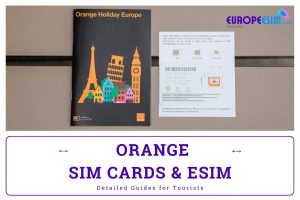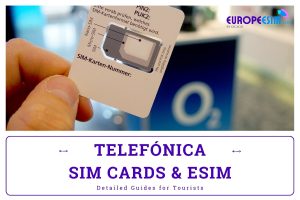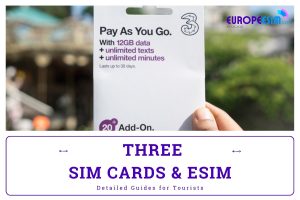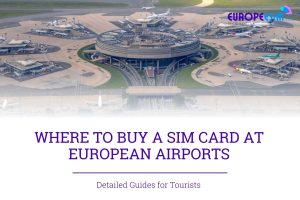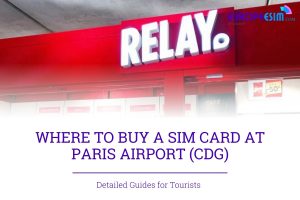Vodafone is one of the largest mobile network operators in Europe. With operations in multiple European countries, a Vodafone SIM card can be a convenient way for travelers to stay connected across the region. This blog post will provide detailed information on using Vodafone SIM cards and eSIM when visiting Europe.
Table of Contents
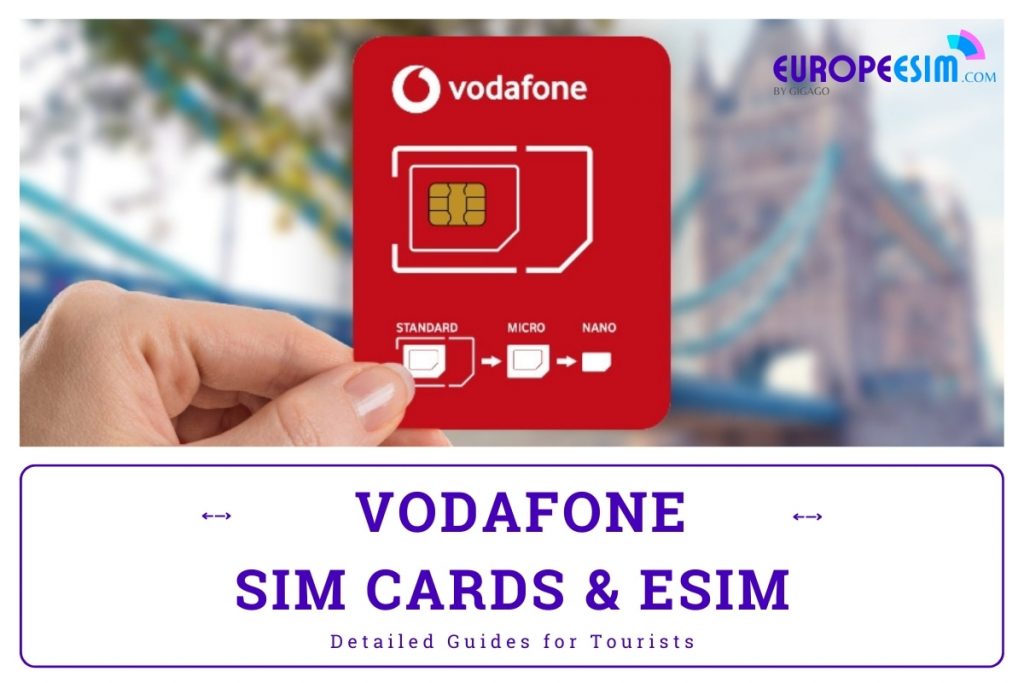
I. Quick facts about Vodafone in Europe
Vodafone has mobile operations in 12 European countries. Some key facts about Vodafone’s presence in Europe:
- Market Size: Vodafone is one of the largest mobile network operators by market share in Europe, serving over 110 million customers across 27 countries.
- Network: Vodafone boasts extensive 4G coverage across Europe and is actively deploying 5G networks in key markets in Western and Southern Europe like Germany, Italy, Spain, and Ireland
- Services: Vodafone offers a wide range of mobile and fixed broadband services, including voice, data, SMS, and fixed-line telephony. They also offer TV packages in some markets. Offers travel eSIMs for convenient connectivity across 45+ European countries.
In summary, Vodafone has widespread mobile coverage across Western, Southern, Northern, Eastern and Central Europe. It is one of the top regional mobile operators that travelers can consider when visiting multiple countries in Europe.

II. Vodafone coverage and speed in Europe
As a major pan-European telecom, Vodafone strives to provide reliable mobile services to customers roaming within the region. However, its coverage and speeds can vary significantly depending on one’s location in Europe.
1. Vodafone coverage

Vodafone has extensive mobile network coverage across the European countries where it operates. Here is an overview of Vodafone’s population coverage in different parts of Europe:
Vodafone coverage in Western Europe:
- Coverage: Near full coverage, reaching over 99% of the population.
- Strong presence in France, Germany, Spain, Portugal, Italy, Ireland, and the United Kingdom.
- Network: 4G and 5G widely available, with ongoing expansion.
Vodafone coverage in Eastern Europe:
- Coverage: Excellent coverage, reaching over 95% of the population in most countries.
- Strong presence in: Poland, Czech Republic, Hungary, Slovakia, Romania, and Bulgaria.
- Network: 4G dominant, with 5G gradually rolling out in major cities.
Vodafone coverage in Southern Europe
- Coverage: Very good coverage, exceeding 90% of the population in most countries.
- Strong presence in Greece, Turkey, Italy, Spain, and Portugal.
- Network: 4G widespread, with 5G available in select tourist destinations and major cities.
Vodafone coverage in Northern Europe
- Coverage: Excellent coverage, reaching almost 100% of the population in some countries.
- Strong presence in Sweden, Norway, Denmark, Finland, and Iceland.
- Network: 4G and 5G are widely available, with advanced network infrastructure in many areas.
2. Vodafone speed
Vodafone’s internet speeds in Europe vary significantly across different regions due to factors like infrastructure development, network upgrades, and regulatory environments. Here’s a brief breakdown:
- Northern Europe: Generally enjoys the fastest average download speeds in many countries like Sweden, Finland, and Denmark. This region benefits from extensive fiber optic networks and strong government initiatives for digitalization.
- Western Europe: Offers a mixed bag, with some countries like Germany and France boasting speeds above 50 Mbps, while others like Spain and Portugal lag. Urban areas tend to have better coverage and speeds compared to rural areas.
- Southern Europe: Faces challenges due to geographical constraints and older infrastructure. Speeds in Italy and Greece often hover around 30-40 Mbps, while Spain and Portugal show some improvement with average speeds reaching 50 Mbps in certain areas.
- Eastern Europe: Shows significant progress in recent years, with countries like Poland and Hungary experiencing rapid fiber optic rollouts. Average download speeds can range from 30-50 Mbps, with certain major cities exceeding 100 Mbps.
In summary, Vodafone provides fast and reliable 4G coverage throughout its European footprint. 5G networks are also being rolled out quickly in major cities and urban areas, bringing ultra-fast speeds.
III. Vodafone connectivity options for travelers to the EU
Some of the main Vodafone mobile connectivity options for travelers visiting the EU include:
| Option | Brief Description | Pros | Cons |
| Prepaid SIM Card | Purchase a local SIM card with a data and/or call plan. Available at airports, Vodafone stores, and retailers. | Affordable, flexible plans. Local number for receiving calls/texts. Can be topped up | Requires SIM card slot. Need to set up APN. May not work with all devices |
| eSIM | Download a virtual SIM card directly to your compatible device. No physical card needed. | Convenient, easy to set up. Multiple plans available. Switch between eSIMs and your home SIM | Limited device compatibility |
| Roaming | Use your existing Vodafone plan while traveling in the EU. | Familiar plan and number. No need to switch SIMs | Can be expensive, especially for data. Not all plans include roaming |
| Mobile WiFi/Hotspot | Rent a portable device that provides Wi-Fi for multiple devices. | Share connection with up to 10 devices. Convenient for group travel. No SIM card needed | Daily rental fees. Limited battery life. May not work in all areas |
Recommendation: The best option for you depends on your individual needs and travel plans. Here's a general guideline:
- Short trips (less than a week): Consider eSIM for convenience or roaming if your plan includes it.
- Longer trips (over a week): Prepaid SIM card/eSIM offer affordability and flexibility.
- Traveling with a group: Mobile WiFi is ideal for sharing data and staying connected.
IV. Vodafone vs. other European mobile operators
Some of Vodafone’s major competitors in Europe include:
- Deutsche Telekom – Largest provider in Germany. Also operates across Europe like Greece, Hungary, Romania, Netherlands.
- Orange – Leading French operator, also has a presence in Europe such as Spain, Poland, Romania, Slovakia, and Belgium.
- Telefónica/O2 – Major operator in Spain and UK that competes with Vodafone.
Compared to other providers, the key advantages of Vodafone are:
- Broader coverage across Europe (Western, Southern, Eastern, Central)
- More uniform data roaming and plans (allows “roam like home”)
- Faster rollout of 5G networks
- Competitive rates for both prepaid and contracts
- Established brand recognition across the continent
So for travelers planning to visit multiple countries, Vodafone may offer better EU-wide roaming and connectivity compared to local brands or smaller regional operators.
V. Best Vodafone SIM cards for tourists & costs
Vodafone offers tourist SIM in some specific countries. Below are some of the best Vodafone tourist SIM options for tourists visiting Europe:
| Vodafone Tourist SIM | Tourist Pack | Price (USD) | Data | Validity | Calling & Texting |
| Vodafone Czech | Data SIM for Visitor 15GB | ~US$21 | 15GB + EU Roaming | - | Unlimited SMS within the Vodafone CZ network free for the first months, then for ~US$17/month. ~US$0.13/minute/SMS to all CZ networks |
| Data SIM for Visitor 20GB | ~US$28 | 20GB | 30 DAYS | Unlimited calls within the Vodafone CZ network 130 minutes outside the Vodafone CZ network free | |
| Vodafone Greece | Voice & Mobile Internet Bundle | ~$ 20 | 25 GB | 20 days | 200 minutes |
| Voice & Mobile Internet Bundle | ~$30 | Unlimited | 30 days | 200 minutes | |
| Vodafone Albania | 3 Day Package | ~$3 | 300MB | 3 days | 300 mins + 30 SMS |
| 10 Day Package | ~$7 | 1.5GB | 10 days | 301 mins + 30 SMS | |
| GIGAMAX Package | ~$15 | 15GB | 21 days | 500 mins + 100 SMS | |
| Tourist Pack | ~$23 | 40GB | 15 days | 1000 mins | |
| Tourist GIGA Pack | ~$29 | 100GB | 21 days | Unlimited | |
| Vodafone Hungary | TUTI100 | ~$2.7 | 100 MB | 30 days | - |
| Vodafone Turkey | Welcom to Turkey Pack | 20GB | 30 days | 750 mins + 250 SMS | |
| 50GB | 30 days | ||||
| Vodafone Italy | Vodafone Holiday SIM | ~ 30 USD | 2 GB in 4G speed | 30 days | 300 mins + 300 SMS |
| Vodafone Dolce Vita | ~ 15 USD | 100 GB in 5G | 30 days | 200 mins + 200 SMS |
Costs range from $10-30 for SIM cards with several GB of data, bundles for calls & texts, and about 1-4 weeks of validity. Tourist SIMs offer great value with discounts on data and unlimited domestic/EU allowances.
VI. Does Vodafone EU support eSIM?
Yes, Vodafone has rolled out eSIM support across most of its European operations.
This allows you to easily activate a Vodafone data plan digitally on eSIM-compatible smartphones when traveling in Europe. eSIMs provide added convenience as you don’t have to visit a store to pick up a physical SIM card.
Vodafone has also launched a Travel eSIM offer for residents of the US and Canada who are visiting Europe.
| Plan | Price (USD) | Data | Validity | Calling & Texting |
| Vodafone Travel Europe eSIM | ~$13 | 5GB | 10 days | - |
| ~$25 | 10GB | 15 days | - | |
| ~$38 | 20GB | 30 days | - |
eSIM support is improving quickly, making it easier for travelers to stay connected across Europe.
VII. Where to buy a Vodafone SIM card and eSIM?
If you need to get a Vodafone SIM card or eSIM for your device, there are a few options for purchasing one.
1. Where to buy Vodafone SIM card for EU travel
You can easily find Vodafone SIM cards at these locations when visiting Europe:
- Vodafone stores – Vodafone retail stores and kiosks in every country sell prepaid SIMs. Stores are there at most airports, train stations, and city centers.
- Supermarkets – Local supermarkets like Tesco (UK), Carrefour (Spain, Italy), Lidl, and Aldi often sell Vodafone prepaid SIM cards.
- Electronics stores – Retailers like MediaMarkt, Saturn, FNAC, etc. also offer Vodafone SIMs in many countries.
- Online – Vodafone prepaid SIMs can be ordered online on Vodafone’s website, Amazon, etc. Some tourist SIMs are exclusively sold online.
- Travel SIM card retailers – Resellers like SimCorner, eeSim, and HolidayPhone sell tourist Vodafone SIMs that can be shipped worldwide.
When buying in person, you’ll need to show your passport and local address proof (hotel details suffice). Purchasing online requires an unlocked phone that’s eSIM/dual-SIM compatible.

2. Where to buy Vodafone eSIM
Vodafone eSIM profiles are available through:
- Vodafone apps – The MyVodafone apps in each country allow activating eSIM plans digitally.
- Vodafone website – eSIM plans can be purchased directly from the Vodafone online store/website and added to your device.
- Third-party eSIM provider – Providers like Europe-eSIM allow the instant purchase of Vodafone eSIM profiles usable globally.
To use Vodafone eSIM, your device must be eSIM compatible and have the latest OS/firmware. Purchasing directly from Vodafone also requires local EU address details in most cases.
Skip SIM Swapping in Europe – Get an eSIM from europe-esim.com
Constantly changing SIM cards as you travel to multiple countries can ruin your European experience. Make life easier with an eSIM from europe-esim.com. Affordable plans from $5 for 3 days, up to 30 days using Vodafone network. Scan and install – local data across Europe. Purchase your eSIM now to stay connected wherever your travels take you!
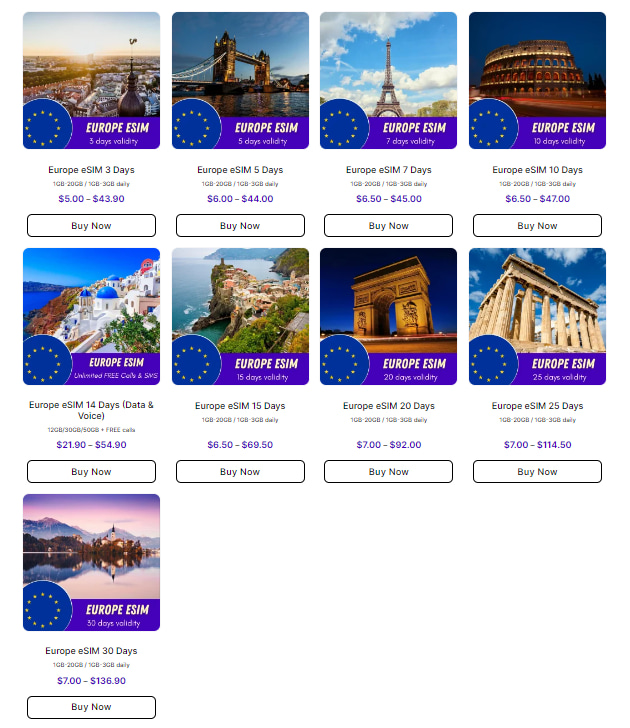
VIII. How to use Vodafone SIM card and eSIM
Once you have your Vodafone SIM card or eSIM setup is complete, it’s easy to start using the cellular service. Here are the basic steps for using both SIM card and eSIM options on Vodafone’s network.
1. How to install and activate a Vodafone SIM card
Follow these steps to install and activate your Vodafone SIM:
- Unlock device – Ensure your phone is carrier unlocked and compatible with European networks.
- Insert SIM – Turn off your phone, locate the SIM tray, and gently insert the Vodafone SIM.
- Setup SIM – Turn on your phone and follow the on-screen prompts to set up your SIM. Enter the PIN code if prompted.
- Activate SIM – You may need to call or text a number to activate your Vodafone prepaid SIM. Dial the activation number and follow the instructions.
- Top-up SIM – Purchase a top-up/recharge voucher at retailer stores or online to add credit to your SIM. Enter the recharge code when prompted.
- Connect to network – Your Vodafone SIM will now connect to the Vodafone mobile network locally and across the EU.
- Configure data settings – Enable mobile data and check APN settings on your phone if prompted. The SIM should work out of the box in most regions.
- Start using – Make calls, send texts, and use mobile data to get started. You can recharge/top-up again whenever required.
2. How to install and activate Vodafone eSIM
Getting started with an Vodafone eSIM for is quite easy as follows:
- Install the eSIM
- Activate the eSIM
- Set up the eSIM
- Start using the eSIM: Once the eSIM is activated and set up, you can start using its services.
Please check your detailed instructions below:
IX. Vodafone Call & SMS rates in the EU
With most Vodafone prepaid plans and tourist SIM cards, you get:
- Local calls – Free or up to $0.20 per minute
- Calls to EU – $0.30 – $0.50 per minute
- Texts to EU – $0.10 – $0.20 per SMS
- Incoming EU calls/texts – Free on most plans
Exact rates can vary slightly by country. But Vodafone offers excellent value when calling or texting from one EU state to another. Calls from an EU Vodafone SIM card back to your home country can cost between €0.19-0.49/minute depending on the destination.
Specialized tourist SIMs often bundle EU calls and SMS for free or very low rates. This allows making long calls at very little cost when traveling around Europe.
X. How to top-up your Vodafone SIM card
You can add more credit to Vodafone prepaid SIMs through:
- Vodafone stores/retailers – Buy top-up vouchers from Vodafone shops and other retailers. Scan or enter the code to recharge.
- Online – Recharge using the Vodafone website or app using a credit/debit card. Provides instant top-up.
- ATMs – Many banks allow recharging prepaid phone credit at ATMs using your debit card.
- Calling – Dial Vodafone top-up numbers for your country and recharge using another phone or credit card.
- Supermarkets/kiosks – Purchase top-up cards at supermarkets, convenience stores, and kiosks.
Online and ATM recharges are the fastest and most convenient. You can add top-ups starting from $5 to $100 depending on country. Data packs, unlimited calls & text bundles can also
XII. FAQs
Q: Does Vodafone have good coverage inside European countries?
A: Yes, Vodafone has population coverage of over 95% for 3G and 4G in most of the European countries where it operates. You’ll get good reception even in rural areas and smaller towns apart from cities.
Q: Can I use mobile internet on Vodafone in Europe?
A: Vodafone has excellent 4G speeds across Europe ranging from 20-60 Mbps on average. All prepaid plans and tourist SIMs include mobile data. 5G networks provide even faster speeds in many urban areas.
Q: How long is a Vodafone prepaid SIM card valid for?
A: Vodafone SIM cards have initial validity periods ranging from 7 days for tourist SIMs to up to 180 days for regular prepaid. You need to recharge/top-up to extend validity to keep using the SIM beyond expiry.
Q: Can I make international calls with Vodafone in Europe?
A: Yes, at very affordable rates too. Calls from EU Vodafone SIM to other EU countries cost between €0.19-0.39 per minute. Special prepaid plans also bundle free or cheap international minutes.
Q: Does Vodafone have good coverage in Eastern European countries?
A: Vodafone has excellent network coverage of over 95% population in Eastern Europe, including Romania, Hungary, Czech Republic where it operates. You’ll get reliable connectivity even in smaller towns and villages.
XIII. Final words
In summary, a Vodafone SIM card or eSIM provides seamless connectivity as you travel across multiple countries in Europe. Their prepaid plans offer great value on local calls & data, discounted EU roaming rates, and easy online recharge options. Tourist SIMs specially optimized for short trips are also available. Vodafone’s extensive coverage, fast 4G/5G speeds, and convenience of keeping the same SIM make it the top mobile network for exploring Europe.




